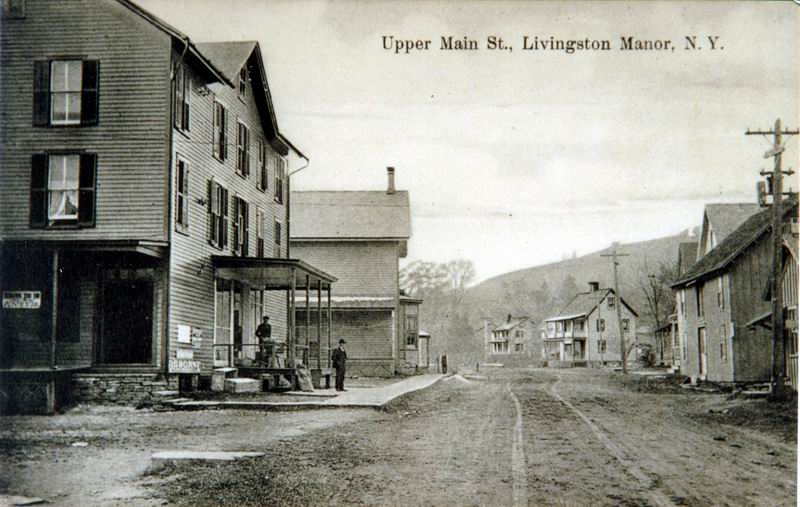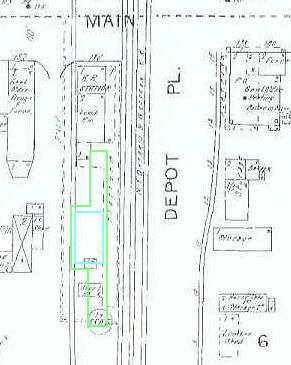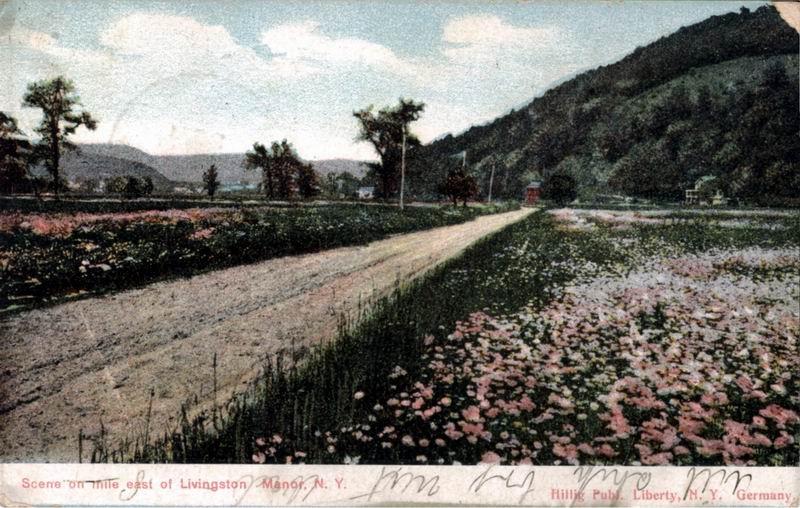Livingston Manor Grange Hall - 1891

The building on the left was the Grange Hall - Fred
In 1889, Cyrus Mott and D.T. Eastman, organized the local farmers to form a local chapter of the Grange and twenty area agriculturalists became the initial membership. It would eventually become so
successful that its membership, for a period of time in the early twentieth century, would exceed that of all the other individual Grange organizations in Sullivan County.
The first order of business for the Grangers would be to find a suitable site to erect a structure; a building that would house their cooperative stores and provide space for a meeting hall. William G. Johnston, a charter member of the local group, sold a portion of his residential lot on DuBois Street to Mott, who was acting as trustee for the Grange, a lot that was located on the corner of Main and DuBois streets. The deal was made in the spring of 1890; the new Grange lot being 50 feet wide, along Dubois Street, and 125 feet in length, along Main Street, covering the area between DuBois Street and the newly created High Street. The Grangers immediately began work on the construction of their new hall. - Fred
"The Grangers are hauling logs to Woolsey & Company's mill to be sawed
into lumber for a new Grange store at Livingston Manor."
June 7, 1890
Walton Reporter
For the remainder on 1890 and throughout the spring of 1891, the
Grangers were busy building their new hall, a rather large structure
that, along with the neighboring and newly renovated Manor Hotel, towered
over the vicinity's businesses and residences. The Grange Hall was 35 feet
in width and 65 feet in length, rising three and one half stories above
Main Street. The first floor would house the Grange cooperative store,
space for storage of commodities and rooms for other small businesses. The
second floor, a large spacious room, became the meeting hall, not just for
the Grangers but for other organizations such as the Rebecca's,
International Order of Odd Fellows and the Grand Army of the Republic. The
upper stories remained unfinished until a change of the building's
ownership. - Fred
"The Grangers of Livingston Manor are putting up a new shed, 20 feet x
48 feet, for the horses of the members."
July 23, 1892
Walton Reporter
In December of 1897, the local Grange chapter sold their building to James
D. Murdock, one of its charter members. The Murdock family are the
earliest of settlers south of the village of Purvis, in the area known as
the flats. Nathan and Mary Murdock's place became known as Valley Farm
when the family erected a boarding house on the premises. James, the son,
continued the farm and expanded the boarding house, utilizing springs on
the property and converting them into a fish hatchery and trout pond for
use by his guests, as well as those brave enough to do some poaching.
Though the creamery on Mott Flat supplied milk for the area residents,
James began a delivery business, perhaps the first in this locale, selling
milk door to door to the village households.
The Valley Farm boarding house and farm was highly successful allowing
James to invest shrewdly in other ventures, the Grange building being one
of those investments. The size of the building offered its new landlord a
sizable rental income, with the store spaces on the first floor and the
potential use of the undeveloped third floor. The second floor remained
the meeting hall for the Grangers and other organizations. - Fred
"James
Murdock has just finished off the third story of the Grange Hall into
living rooms suitable for two families."
October 13, 1898
Roscoe-Rockland Review
James D. Murdock utilized his Grange Hall building to its fullest extent. On the ground floor the Grange store remained, with Frank
Smith and Maurettus Finch as the proprietors, along with the produce grocery store of Myron Vanderlyn, which sported a new soda fountain. At the upper end of the building was the small millinery store of Miss Ethel Vanderlyn. Murdock finished off the building's third floor, creating two residential apartments.
The meeting hall on the second floor also went through some modifications. Added were lodge rooms for the fraternal
organizations' use as meeting and business rooms. One room was fitted to become the school district's kindergarten room. The large
meeting hall, though somewhat smaller, still had ample space for the Granger's district meetings, and served the community and its
organizations for general assemblies, dances and other entertainment. A piano was donated to the hall by Mrs. Nellie DeKay, who utilized the hall with music recitals sponsored by the students of her music class and the professional musicians she was able to lure to the Manor to perform. Until Fontana's Opera House was opened some years later, this hall served as the year-round meeting and
entertainment hall for the community. - Fred
"Mrs. Thomas White has purchased of James Murdock of Arena, the tenement
building, corner of Main and Church streets in this village. Mrs. White
removes from the Grange hall to her newly acquired property and is
making some needed repairs upon the same."
June 18, 1908
Sullivan County Review
The purchase of the Grange Hall lot provided another economic
opportunity for Murdock. The twenty foot wide stable that was erected by
the Grangers along the south side of the lot, to house the members'
horses, may have been an important auxiliary building for the Grangers,
but not to Murdock. Far more profit could be had by housing people
instead of horses and in 1900, opportunity knocked on Murdock's door.
 1897 Sanborn
map, showing the location of the old railroad station. A rough sketch on
the map has been included to denote the location of the new station,
including the passenger platform, in relation to the old depot. Its not
exact, but pretty close. The H.L. Sprague & Co. building is to the old
depot's immediate left and the A.P. DuBois & Co. building to its
immediate right.
1897 Sanborn
map, showing the location of the old railroad station. A rough sketch on
the map has been included to denote the location of the new station,
including the passenger platform, in relation to the old depot. Its not
exact, but pretty close. The H.L. Sprague & Co. building is to the old
depot's immediate left and the A.P. DuBois & Co. building to its
immediate right.
Officials of the railroad had decided that the current depot building at
the Manor needed to be replaced. The structure was built in 1882,
replacing the original Midland railroad's depot that had burned to the
ground by the presumed acts of an arsonist. The new station would be
located farther away from the Main Street crossing, behind the old
depot. When passenger trains stopped at the current depot, they would
often block the traffic at the Main Street crossing, for long periods of
time and on a regular basis. The new location would disrupt traffic at
this crossing less frequently.
Work began in the spring of 1900 on the new station. The plan was for
the railroad to keep using the old depot while the new structure was
being built, and when nearly completed (a portion of the new passenger
area would be located on the old depot's site) to have the old depot
removed. Bids that went out specified that the old building would have
to be removed by the successful bidder within six days' time. - Fred

I know of only one other photograph that shows the old depot in its
original position. This photograph shows the A.P. DuBois Co. store
with the depot behind it. - Fred
The dimensions of the old O&W depot was a perfect fit to place on
James D. Murdock's Grange Hall lot. The shed built by the Grangers
against Church Street to house their horses was 20 x 48 feet. The
depot, which was 25 x 70 feet, would fit, with little alteration of
the old shed's foundation, within the same location and give Murdock a
substantial structure which could be renovated and used for other
purposes. Murdock bought the old depot.
Throughout the summer and fall of 1900, railroad carpenters laid the
foundation and raised the new structure that would house the new O&W
station. During this same period, Murdock removed the horse shed off
of the Grange lot, excavated the cellar and prepared new foundation
walls for the coming structure. By October, the finishing touches to
the new railroad station and final grading of the area's grounds were
nearing completion. At the end of the month, the railroad assumed
occupancy of the new station, just as the sills on the foundation for
the old depot's new home were completed. Murdock now had six days, as
agreed upon by Murdock and the railroad officials, to remove the old
depot. - Fred
"Preparations are being made to start the old depot on its way
rejoicing up the Cattail. It has outlived its usefullness where it now
stands."
October 25, 1900
Roscoe-Rockland Review
Moving the old depot to its new location would be no easy task.
With the building boom going on at the Manor, skilled tradesmen were
plentiful, but few had the resourcefulness for such an endeavor as
Charles Wright. A mason by trade, Wright specialized in raising and
moving buildings and was considered the best for the job on hand by
James Murdock.
The major concern about the moving of the old depot was the length of
the structure. Being seventy feet long, problems would have to be
overcome with the move, including the total weight of the building and
the possibility of damaging the structure once off its current
foundation and on the move. To help solve this dilemma, the depot was
separated into two halves, making an easier pull for the draft animals
as well as being more manageable during its roll down Main Street.
On October 25th, 1890, Wright and his crew began jacking up the first
half of the building to place wooden rollers upon the foundation. The
building was then set back down on the rollers and pulled off the end
of the foundation onto waiting wooden cribs, which when removed,
allowed the building to sit on rollers laying upon the ground. It was
then pulled by the draft animals straight onto Main Street, raised
again to allow the rollers to be placed at right angles to their
previous position, and then towed down Main Street to its future home.
Once in front of the Grange Hall lot's foundation, the process was
reversed until the depot was positioned on its new sills. By November
1st, Wright and his crew had both halves of the old depot in position
at its new location, waiting for the carpenters to reassemble the
structure and begin the work of interior alterations.- Fred
"J.L. Murdock will soon have the old depot ready for occupancy. It
has been plastered and made into commodious dwelling rooms."
March 1, 1901
Liberty Register
The Old Station Converted as it is today
The financial endeavors of James D. Murdock at Livingston Manor
ended abruptly shortly after the moving and alteration of the old
depot by his moving to Arena, in Delaware County. Though no reason has
been found for this sudden move, perhaps a family tragedy may be
partially to blame.
Livingston Manor, nestled in the Willowemoc Valley in the western
Catskills, is well protected from the harsh northeast weather by the
surrounding hills. Unfortunately, this same geography can also provide
unhealthy conditions which, in the past, resulted often with deadly
results. The local acid factory, though a major economic contributor
to the region, was also a major contributor of pollution, both to the
air and the streams. The factory's retorts burned wood in a slow
fashion with the smoke that went up the stack being filled with water
vapor laced with the wood chemicals from the smoldering, unburned
wood. When weather conditions were right, the factory's discharge,
along with the smoke from burned wood and coal belching from the
chimneys of local residences, would lay low in the valley, often
combining with the morning fog, creating a chemical laced gas, inhaled
by all. It is no wonder that repiratory diseases, particularly
tuberculosis, was as prevalent as it was during these times.
Louisa Murdock, the 17 year-old daughter of James and Minnie Murdock,
came down with a mild cold in December of 1903. Though always
considered to be in the peak of health throughout her short life,
Louisa never recuperated from this seemingly minor malady, eventually
becoming bed-ridden with what was then called consumption, or
tuberculosis, dying the following spring. On a beautiful spring-like
day, June 12th of 1904, James D. Murdock buried his daughter. - Fred
"John Morris has leased of J.D. Murdock his boarding house."
January 14, 1904
Roscoe-Rockland Review
With James D. Murdock leaving the Manor area for Arena, he disposed
of his Livingston Manor interests. The Grange Hall lot was divided
into two parcels. The old depot, which had been converted into
residential apartments, was sold to Katherine White. Katherine and her
husband, Thomas, ran the old hotel, The Willowemoc House, located at
the east end of the covered bridge since 1885, retiring from that
business and taking up lodging above the Grange Hall. She was the
mother of John White, the supposed New York Giant major league
baseball player.
The Grange Hall was sold to R.J. Kay, the fellow whose name was
inscribed on the walls of the Gilbert DuBois house.
The Murdock farm was leased to John and Maude Morris, residents of New York City. This would prove to be a costly agreement for Murdock. - Fred

James Murdock Farm ./ Boarding house - Still there today just
past the airport